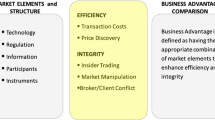Abstract
Technological developments have permitted rapid changes in the structures of securities trading markets. These changes call for a reevaluation of regulatory regimes. For example, because divergent market structures competing for order flow may fall within different regulatory structures, the proper allocation of regulatory costs should be weighed. Because of the open access by all investors to all markets that technology permits, regulators need to examine the level of oversight necessary to ensure the protection of investors. Because of existing statutory limits, automated systems may pose particular problems in the U.S. regarding the appropriate levels of regulation for non-intermediated trading and cross-border systems that are regulated by an overseas authority. On another topic, automation facilitates increased transparency. In turn, transparency promotes investor protection, encourages market liquidity, and fosters the efficiency of securities markets by facilitating price discovery and open competition, thus reducing the effects of fragmentation. In the end, because it enhances the efficiency of the market's price discovery function and liquidity, transparancy contributes to the efficient allocation of scarce capital among competing demands for that capital. Finally, regulators should participate in the review of automated systems integrity, especially in the areas of capacity, security, and disaster recovery.
Similar content being viewed by others
References
Board of Trade of the City of Chicago v. Securities and Exchange Commission, 923 F.2d 1270 (7th Cir. 1991),rehearing en banc denied, No. 90-1246 (7th Cir. April 2, 1991).
Breeden, Richard C.Testimony Concerning the Govemment Securities Market Before the Subcommittee on Securities of the Senate Committee on Banking, Housing, and Urban Affairs (September 11, 1991), 14–17.
Financial Services Act 1986, as amended, section 40(2).
Friedman, Milton. “How to Sell Government Securities.”Wall Street Journal (August 28, 1991), A8, col. 3.
Gammill, and Perold. “The Changing Character of Stock Market Liquidity.”Journal of Portfolio Management 15 (Spring 1989), 13.
Hardiman, Joseph. “Automation and Electronic Trading: Key Issues for Regulation in a New Era.” 16th Annual Conference, International Organization of Securities Commissions (September 1991), pp. 4, 8.
Harris, L. “Consolidation, Fragmentation, Segmentation, and Regulation” 17–19 (March 1992).
Huang, and Stoll. “Major World Equity Markets: Current Structure and Prospects For Change.”Monograph Series in Finance & Economics 16.
International Organization of Securities Commissions (“IOSCO”) report entitled “Principles for the Oversight of Screen-based Trading Systems,” (June 1990).
Intervention de Didier Davydoff, Chef du Service des Etudes du Development des Marches de la Commission des Operations de Bourse, 16th Annual Conference, International Organization of Securities Commissions (September 1991).
“Salomon Scandal Calls for Auction Overhaul.”Wall Street Journal (August 26, 1991), A1, col. 5.
Securities Exchange Act Release No. 26708 (April 11, 1989), 54 FR 15429 (Proposed 15c2-10).
Securities Exchange Act Release No. 27445 (November 16, 1989), 54 FR 48703.
Securities Exchange Act Release No. 28899 (February 20, 1991), 56 FR 8377 (granting Wunsch Auction System, Inc. (“WASI”) an exemption from exchange registration).
Securities Exchange Act Release No. 29185 (May 9, 1991), 56 FR 22490.
Securities Exchange Act Release No. 30920, Int'l Series Release No. 420, File No. S7-18-92 (July 14, 1992).
Author information
Authors and Affiliations
Additional information
National Association of Securities Dealers, Inc.
A significant portion of this article appeared in a paper prepared by the Division of Market Regulation of the U.S. Securities and Exchange Commission for the 1991 Annual Conference of the International Organization of Securities Commissions, Panel on Automated Trading, September 26, 1991.
The Securities and Exchange Commission, as a matter of policy, disclaims responsibility for any private publication or statements by any of its employees. The views expressed herein are those of the authors and do not necessarily reflect those of the Commission or the other members of the staff of the Commission.
Mr. Adkins' contribution to this article occurred while he was a staff member of the Securities and Exchange Commission. The views expressed herein are those of Mr. Adkins only and do not necessarily reflect those of the Commission, the National Association of Securities Dealers, Inc., or members of the staffs of the Commission or the NASD.
Rights and permissions
About this article
Cite this article
Becker, B., Lopez, E., Berberi-Doumar, V. et al. Automated securities trading. J Finan Serv Res 6, 327–341 (1993). https://doi.org/10.1007/BF01046074
Issue Date:
DOI: https://doi.org/10.1007/BF01046074




